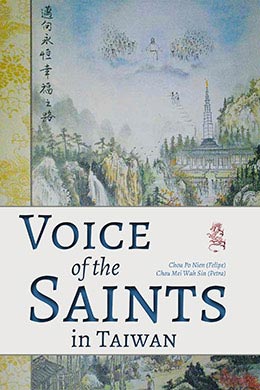Come, Listen to a Prophet’s Voice
First Area Conference, Stake, and Chinese Mission President (1975–85)
Chou Po Nien (Felipe) (周伯彥) and Chou Sin Mei Wah (Petra) (周冼美華), “Come, Listen to a Prophet's Voice: First Area Conference, Stake, and Chinese Mission President (1975-85),” in Voice of the Saints in Taiwan, ed. Po Nien (Felipe) Chou (周伯彥) and Petra Mei Wah Sin Chou (周冼美華) (Provo, UT: Religious Studies Center; Salt Lake City: Deseret Book, 2017), 179-214.
As the delicate political environment continued to unfold in Taiwan during the 1970s and 1980s, the Church continued to grow and expand. How did the first area conference and first stake in Taiwan affect the Church in the 1970s? This chapter discusses the visit of the President of the Church, Spencer W. Kimball, to the island in 1975, followed by the creation of its first stake. It also provides details of President Kimball’s second visit, in 1980, which further strengthened the relationship of the Church with the government in Taiwan. It examines the changes to missions and stakes in Taiwan in the midst of the political atmosphere, as well as the call of the first Chinese mission president. As the LDS Church adhered to its position of political neutrality, it avoided difficulties experienced by the Presbyterian Church in Taiwan (PCT) and US officials during the tense political environment of this period in history. The Saints in Taiwan were blessed by accepting the invitation to “come, listen to a prophet’s voice.”[1]
First Area Conference and Visit by the President of the Church
Throughout the 1970s, various Church leaders visited Taiwan to teach, train, preside, and conduct Church business. There were many visits by members of the First Presidency and the Quorum of the Twelve Apostles, including Elder Bruce R. McConkie in 1970, Presidents Harold B. Lee and N. Eldon Tanner in 1971, Elder Howard W. Hunter in 1975, President Ezra Taft Benson in 1978, and Elder Gordon B. Hinckley on multiple occasions. Others like Elder Marvin J. Ashton, then an Assistant to the Twelve; Patriarch to the Church, Eldred G. Smith; and Elder A. Theodore Tuttle of the First Council of the Seventy also visited the Saints in Taiwan.[2] The most memorable visit was by the President of the Church, Spencer W. Kimball, in 1975.
During this period, the general conferences of the Church in Salt Lake City were not easily accessible to members of the Church in various locations around the globe, including Taiwan. Area conferences provided an opportunity for Church leaders from Salt Lake to visit with members in various areas of the world, providing these members with the opportunity to hear General Authorities teach and train in person.[3] When President Spencer W. Kimball visited Taiwan in 1975, he was the first President of the Church to do so, and the area conference held on 14 August 1975 was the first of its kind in Taiwan.[4]
The announcement in May 1975 that President Kimball was coming to Taiwan in August to preside over the first area conference was very timely. It came shortly after Chiang Kai-shek, the president of Taiwan, had passed away in April 1975. Chiang’s vice president, Yen Chia-kan, was serving as interim president at this time.[5] This political transition left concerns and uncertainty regarding the political future of Taiwan and its relationship with China.[6] President Nielson, the mission president in Taiwan, published “In Remembrance of President Chiang” in the Voice of the Saints, noting that Chiang was a good man and president who was a spiritual leader and loved by everyone. Nielson urged the people to have courage and pray for the Spirit so that they might lead this country to freedom in a time of uncertainty.[7] The Saints’ respect for the government facilitated President Kimball’s visit with the new president of Taiwan.
Prior to the arrival of President Kimball, there was much planning and preparation done by the members and the Church leaders in Taiwan. Throughout the 1970s, most Church meetings were held in rented halls, apartments, or homes. In 1975, when President Spencer W. Kimball visited Taiwan, there were only three Church-owned chapels in Taiwan, which included Taipei (the first chapel dedicated in Taiwan by Elder Hinckley on 16 October 1966), Kaohsiung, and Taichung. However, a larger venue would be needed to accommodate this area conference. The following excerpt demonstrates how the Saints’ diligent preparation was crucial for the success of this area conference:
Near the end of May, when the area conference was announced, the planning and preparation were taken over completely by the local leadership. A major planning council of twenty members was called, [with] the mission president acting only as an adviser. To fulfill their responsibility, the council met for a two-hour session each week for two months. They secured the meeting facilities, arranged for out-of-town members to stay with members in the Taipei area, and rented “conference buses” for members in the southern part of the island. The council also took care of publicity, set up press conferences and interviews for the General Authorities, ensured the attendance of high government and civic leaders, and arranged for President Kimball and others to meet with several heads of state. . . .
Under the guidance of these able priesthood brethren, the Saints of Taiwan were prepared to meet the Prophet. Announcements were made incessantly. Branch leaders strove to contact every member, that this rare opportunity might not be lost. Choirs were formed in the larger branches, with members of smaller branches joining these efforts.[8]
Church members and missionaries in Taiwan assisted with hotel and meeting-hall preparations, as well as transportation, public relations, choir, and so forth. No effort was spared to invite every Church member and to reach out to the general public. President Nielson credited the members and local leaders for the success of President Kimball’s visit.[9] The area conference was held in the Dr. Sun Yat-sen Memorial Hall in Taipei, with about 2,500 Church members and friends in attendance. Many saw and heard a living prophet of God in person, and many more were able to hear President Kimball by means of radio and television. Elder Kevin Moss, who attended the conference, recorded the following:
When the opening day of conference came, over 2,500 members, missionaries, investigators, and other guests filled the Dr. Sun Yat-sen Memorial Hall with an increasingly expectant mood. The expectations were not in vain. Words came alive under the voices of the General Authorities.
Elder Theodore M. Burton delivered a pertinent talk on “the best and true way to revere ancestors”: genealogy and temple work. Elder Adney Y. Komatsu gave his encouragement to those who encounter family and tradition problems because of their testimonies. . . .
Between sessions the hours were full. President Ezra Taft Benson was the guest speaker at a special “prayer breakfast” held by thirty top Chinese and American officials. His address was penetrating and personal as he recounted some of his experiences and bore testimony of a living God. In the afternoon, President Spencer W. Kimball arrived from Hong Kong with other General Authorities. They were joyously received by a large crowd of Chinese members—“a gracious and respectful mobbing,” as one elder put it.[10]
During the general session of the area conference, President Kimball talked about temples and announced the plans to build a temple in Tokyo, Japan. On the topic, President Kimball said the following:
Last Saturday there was a great announcement made in Tokyo, Japan [at the Area Conference there], that we would build a temple in Japan, and this would be for all of the people of Asia. I am sure that you would like to have a temple here in your own land, but it takes many, many people to operate a temple. And so we have hopes, probably as you do, that the day will come when there could be a temple here. In the meantime, we will build a temple for the Asian countries in Japan. And we hope that the shorter distance to Japan will enable you, nearly all of you, eventually to go to the temple for your sacred endowments.
We hope that all of these boys and girls will plan their marriages in the holy temple. Perhaps they can begin to save their money even now so that when the time comes, they can have the ordinances completed in the holy temple of God.
There could be little progress if there were no temples for the temple work to be done. And so we urge you, as families, to get busy with your genealogical data. For centuries you have been a family-oriented land and people. Perhaps you will not have as much difficulty tracing your genealogy back as we might have. You have had many ancestors for centuries who have been good people. Many of them would have joined the Church if it would have been available to you and to all of your ancestors.[11]
The members were excited and overjoyed to hear the prophet’s proposal to build a temple in Tokyo and raised their right hand to show their support. Sister Chang Huang Yung Wei (張黄永薇) said, “It was a blessing to attend the area conference and hear President Kimball.” Her family, like many others, would save money and eventually travel to Japan to be sealed in the Tokyo Temple.[12]
In addition to the announcement of the first temple in Asia, President Kimball also taught about the importance of missionary work. The following account from this time period illustrates the faith of the youth in hearkening to the call to assist with missionary work:
Just weeks after his baptism at age 15, Chen Hsin Shun [or Chen Hsin-Hsiung] [陳信雄] helped members from all over the island find overnight accommodations during Taiwan’s first regional conference, when President Spencer W. Kimball addressed more than 2,500 listeners in Taipei on 14 August 1975. Brother Chen learned early to exercise his faith about economic challenges and make sacrifices for the Church. While he was preparing for his mission, his family’s business failed and he was asked to help support the family. He told his father, “Trust my God for three months, and see if he doesn’t bless the family while I’m on a mission.” His father agreed to the experiment, and Brother Chen prayed hard for blessings. About a month and a half into his mission, he received a letter from his father saying he wouldn’t need to come back early because the family’s business had signed a lucrative 10-year contract.[13]
After the conference, members and missionaries in Taiwan redoubled their efforts to increase the number of baptisms and worthy members, and by November 1984, the Taipei Taiwan Temple was dedicated by President Gordon B. Hinckley, an event further discussed in the chapter 7.[14]
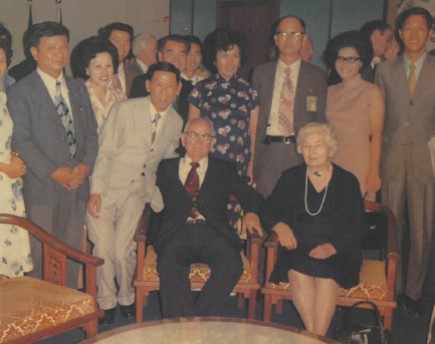 President Spencer W. Kimball visits Taiwan in August 1975. Courtesy of Chang Ting-Tsung.
President Spencer W. Kimball visits Taiwan in August 1975. Courtesy of Chang Ting-Tsung.
In addition to speaking to the Saints, President Kimball and others had the opportunity to visit with government leaders. Kevin Moss records of the experience:
After a press conference at the Grand Hotel, President Kimball, President Benson, and Brother David Kennedy were taken to meet Yen Chia-Kan, president of the Republic of China. Together they spent forty-five minutes discussing genealogy and the role of the family. President Kimball also explained the Church Welfare System, which impressed President Yen, who pointed out similarities between it and the operation of some of the ancient family clans. President Yen was presented with a beautiful, white, leather-bound edition of the Book of Mormon.[15]
This meeting was a historic opportunity for Church leaders to outline the Church’s teachings regarding genealogical and temple work and welfare services. Although President Ezra Taft Benson, in the capacity of US secretary of agriculture, had previously met with Chiang Kai-shek, then the president of Taiwan, this meeting between Kimball and Yen represented the highest official meeting between Church leaders and the Taiwanese government. The exchange helped to further improve the image of the Church in Taiwan and bolster relations between the Church and the government in Taiwan.[16]
The First Stake in Taiwan
In 1975 there were thirty branches and over seven thousand members in three member districts in the mission and an American servicemen’s district. Even though it was very difficult to get permission from the government to leave the country to do temple work, the members in Taiwan were tracing their genealogy back thousands of years and preparing for the blessings of the temple.[17]
After the area conference in August 1975, and with much prayerful consideration, President Nielson submitted a proposal to the First Presidency to create the first stake in Taiwan. On 13 January 1976 he was notified that his request was approved. Several weeks later, he also received word that the Taiwan Taipei Mission was to be divided to create the Taiwan Kaohsiung Mission. Nielson and other Church leaders were excited to receive the news from Salt Lake City. Elder Gordon B. Hinckley arrived in Taipei on 19 April 1976 and selected Chang I-Ching (張漪清) to be the first Chinese stake president. Chang became the stake president when the Taipei Taiwan Stake was created on 22 April 1976, with six wards, five branches, and 4,497 members.[18] The Ensign reported these achievements as follows:
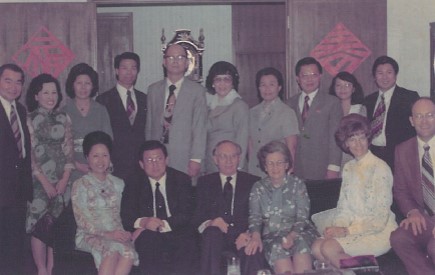 The Taipei Stake (first stake in Taiwan) is organized by Elder Gordon B. Hinckley in 1976. Back row from left to right: Liang Jun-Sheng and wife (first counselor Taipei Stake), Wang Hsu Hsueh and wife (district president in Kaohsiung), Chang I-Ching and wife (president of Taipei Stake), Yan Yaun-Hu and wife (district president in Taichung), Wan Kon-Leung (second counselor of Taipei Stake). Front row from left to right: Elder and Sister Komatsu, Elder and Sister Hinckley. Courtesy of Chang Ting-Tsung.
The Taipei Stake (first stake in Taiwan) is organized by Elder Gordon B. Hinckley in 1976. Back row from left to right: Liang Jun-Sheng and wife (first counselor Taipei Stake), Wang Hsu Hsueh and wife (district president in Kaohsiung), Chang I-Ching and wife (president of Taipei Stake), Yan Yaun-Hu and wife (district president in Taichung), Wan Kon-Leung (second counselor of Taipei Stake). Front row from left to right: Elder and Sister Komatsu, Elder and Sister Hinckley. Courtesy of Chang Ting-Tsung.
Two major milestones in the history of the Church in the Far East were reached April 22 and April 25 when the first stakes were organized in Taiwan and Hong Kong, representing the first stakes among the Chinese peoples. . . .
The new stakes were organized under the direction of Elder Gordon B. Hinckley of the Council of the Twelve, assisted by Elder Adney Y. Komatsu, Assistant to the Council of the Twelve and the area supervisor for the Far East.[19]
President Chang I-Ching selected Liang Jun-sheng (梁潤生) as his first counselor and Wan Kon-Leung (Joseph) (尹根亮) as his second counselor. While Brothers Chang and Liang were more seasoned men in their late fifties, Brother Wan (CES coordinator in Taipei) was only thirty-two years old at the time. Brother Wan was teaching institute one night when missionaries came to inform him that Elder Hinckley wanted to meet with him. He noted that Elder Hinckley met with him and said, “We would like to call you to be the second counselor in the stake presidency. Would you like to work with these two old men?” Brother Wan responded by saying, “Who is older than Heavenly Father and Jesus Christ? Of course I would like to work with them.”[20]
Chang I-Ching was a high-ranking Chinese military officer who moved from Canton [Guangzhou], China, to Taiwan after World War II. Missionaries knocked on his door in Hsinchu many times in 1961, and he politely turned them away every time. But one day, while he was not home, the missionaries came calling again and found his wife, Chuang Hsing (邢莊), home. In keeping with traditional Chinese custom and etiquette, she politely invited the two missionaries in and prepared a meal for them. Chang later said, “There I was, trying my best to discourage those young men from coming back, and my wife was feeding them.”[21] Six months after his baptism, he was called as a branch president; his wife would later serve as the branch Relief Society president, and together they served the members of their small branch.
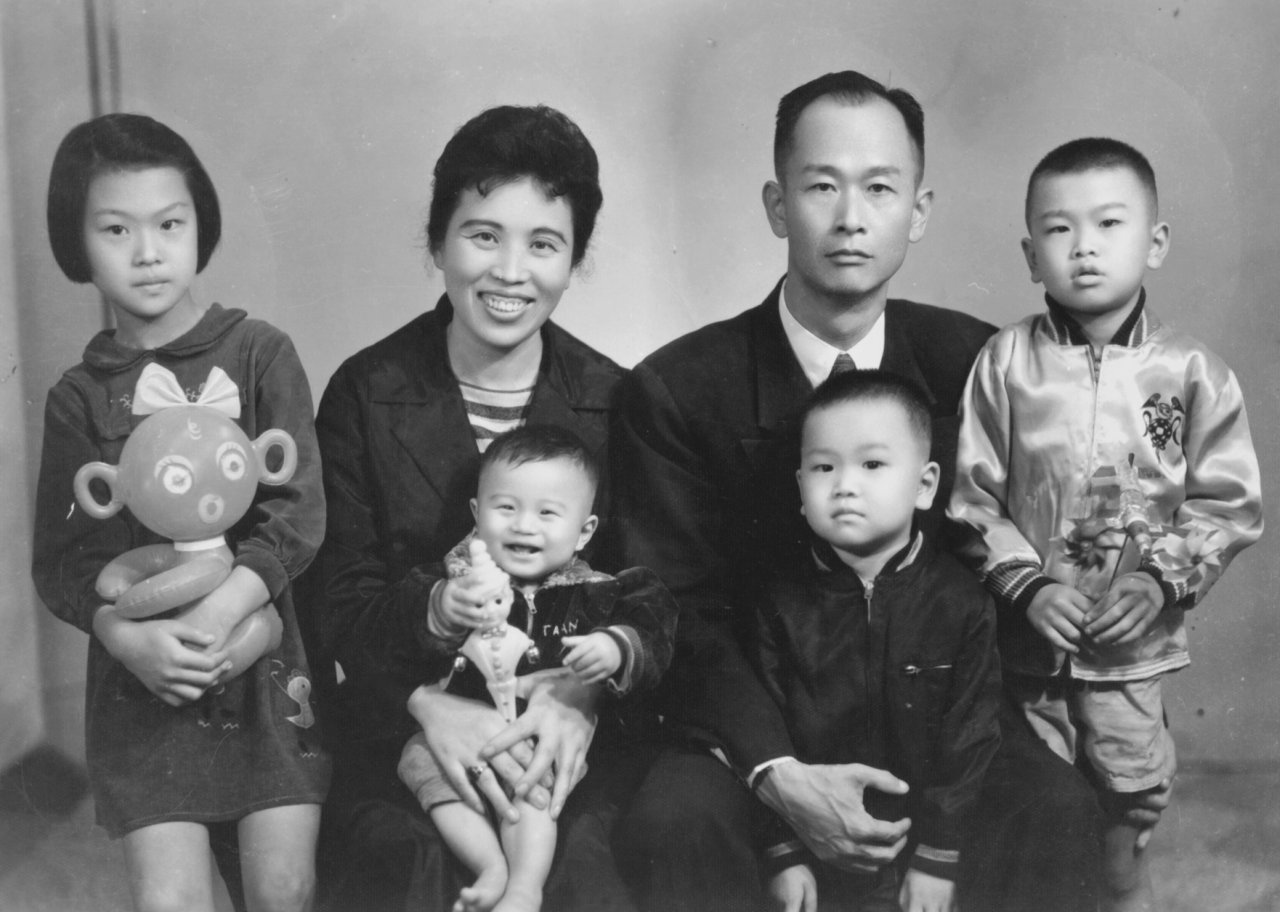 Chang I-Ching and family, circa 1961. Chang became the first stake president in Taiwan in 1976. Courtesy of Phil and Brenda Frandsen.
Chang I-Ching and family, circa 1961. Chang became the first stake president in Taiwan in 1976. Courtesy of Phil and Brenda Frandsen.
Chang resigned from the military and became a teacher and educational administrator. He had a desire to help the poor by improving their education and financial situation and would later open a school to help students prepare for college, enrolling some four thousand students on seven campuses. One member noted that Chang bought a restaurant just to provide jobs for Church members and to help feed the missionaries. When asked how many people he had helped over the years with a job, financial advice, or loan, he modestly responded, “All I have, the Lord gave to me. It is not mine to keep.” His kindness, compassion, and gentle nature were blessings to many.[22]
Liang Jun-sheng, who served as the first counselor in the first stake presidency in Taiwan, had served in various positions in the Church, including serving as the first native branch president in Taiwan. He was among those that helped to raise a second-generation LDS family in Asia. His two sons, Liang Shih-An (Kent) (梁世安) and Liang Shih-Wei (Carl) (梁世威), would both serve as a bishops and stake presidents in the future. Liang Shih-An would also serve as a regional representative and become the first member in Taiwan to be called as an Area Authority and Area Seventy of the Church in 1995 and 1997 respectively.[23]
Twenty years after the first missionaries arrived in Taiwan, the first stake in Taiwan was organized. Following Chang I-Ching’s service, others would be called as stake presidents for the Taipei Taiwan Stake (renamed the Taipei Taiwan West Stake on 14 March 1982).[24]
The creation of the first stake in Taiwan was a significant milestone in the history, development, and growth of the Church in Taiwan. The organization of a stake also included the calling of bishops instead of branch presidents, as well as a stake patriarch, which made patriarchal blessings available to members of the Church, as districts do not have patriarchs.[25] Wang Ping-Huang (王炳煌) was among the first to be ordained to the office of a bishop. Hu Wei-I, who translated the Book of Mormon into Chinese, became the first stake patriarch for the Church in Taiwan.[26] While a district is supervised by a mission president, a stake is independent of the mission and supervised by a stake president. The establishment of the first stake of Zion in Taiwan, administered by local leaders, indicated the growing strength and maturity of the local leadership.
Efforts in the 1960s and early 1970s to help members go to the Laie Hawaii Temple were met with difficulties due to the financial cost and government restrictions.[27] During this period, it was difficult to receive permission from the government to leave Taiwan in order to attend a temple.[28] But following the creation of the first stake in Taiwan, the First Presidency sent an invitation to the newly called stake presidency and bishops to travel to Church headquarters for general conference. This letter of invitation allowed these local leaders to obtain a visa from the Taiwanese government, which was a rare and unique blessing. Wang Ping-Huang’s daughter remembers the excitement her father felt in receiving permission from the government to travel with others to Utah in 1977. Because the Salt Lake Temple was closed during general conference, these leaders went to the Provo Utah Temple to receive their temple blessings.[29]
Missions Created, Then Consolidated
In the midst of the political situation during this time, the Church quickly added a second and third mission in Taiwan. However, it would later consolidate these missions while continuing its efforts to move the work of salvation forward among the people in Taiwan.
A Second Mission Organized
Several weeks after President Nielson was notified that his proposal to create the first stake in Taiwan was approved, he was surprised to receive word that the Taiwan Taipei Mission was to be divided to create a second mission in Taiwan. Nielson and other Church leaders were excited to receive this news from Church headquarters in Salt Lake City. On 1 July 1976, the Taiwan Kaohsiung Mission was created, and P. Boyd Hales served as its first mission president from 1976 to 1979. President Thomas P. Nielson, called in 1974, remained the mission president for the Taiwan Taipei Mission. The new Taiwan Kaohsiung Mission had 3,600 members, while the Taiwan Taipei Mission had 4,600 after it was divided.[30]
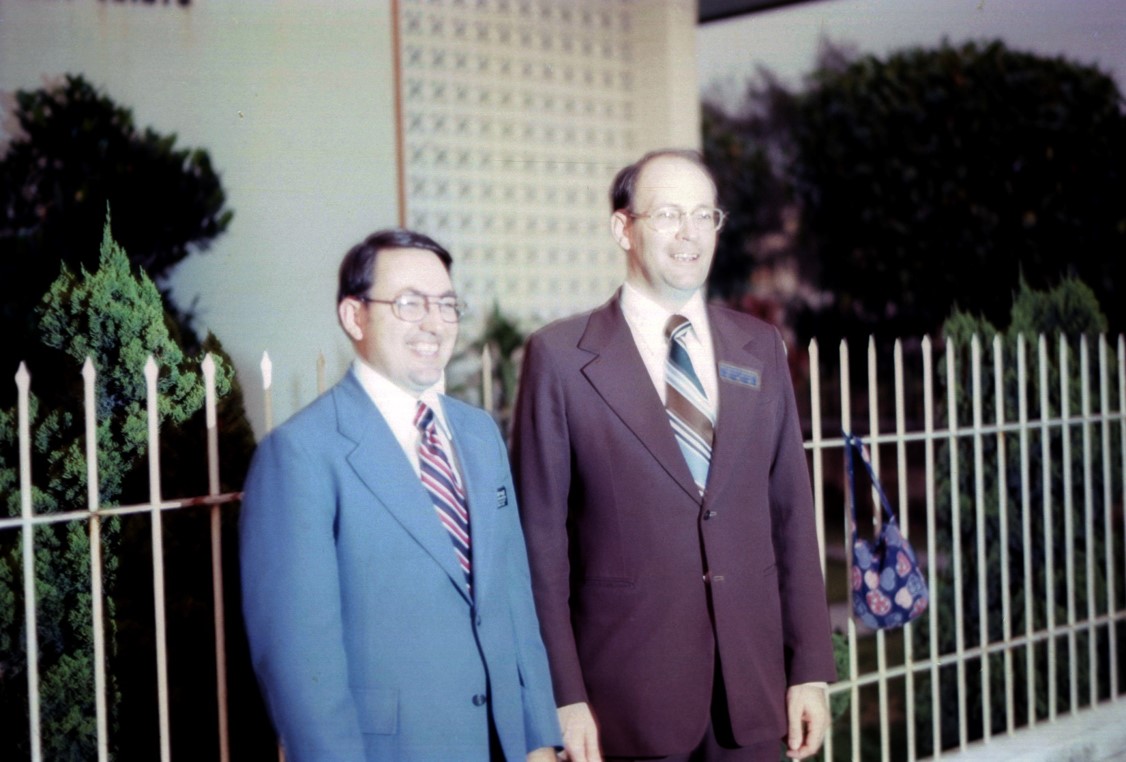 Kaohsiung Mission president P. Boyd Hales and Taipei Mission president Thomas Nielson in 1976. Courtesy of Phil and Brenda Frandsen.
Kaohsiung Mission president P. Boyd Hales and Taipei Mission president Thomas Nielson in 1976. Courtesy of Phil and Brenda Frandsen.
The creation of the second mission was a significant event because it reflected the growth and development of the Church in Taiwan. Across the Taiwan Straits, Mao Zedong had passed away on 9 September 1976, and Deng Xiaoping emerged as his successor.[31] With the passing of Mao in China in 1976, one year after the passing of Chiang Kai-shek in Taiwan, it was unclear how the relationship between Taiwan and mainland China might change with their political successors. Notwithstanding the uncertainty and changing political dynamics in the region, the Church continued to progress. The creation of the first stake and second mission were the highlight of the growth experienced in 1976.[32]
Although missionary work among the Chinese began in Hong Kong, and most Chinese converts were in Hong Kong, that changed by the late 1970s. The establishment of the Taiwan Mission in 1971 was significant in furthering the pace of the work in Taiwan, as missionary efforts received local direction and supervision. By 1977, when Frederick W. Crook replaced Thomas P. Nielson as the mission president for the Taiwan Taipei Mission, total membership in Taiwan had surpassed membership in Hong Kong. In 1977, there were 7,933 members in Taiwan compared to 4,256 in Hong Kong.[33] Crook’s PhD in economics and special training in Asian affairs aided him in accelerating the work in Taiwan.
Political Situation and Creation of Taiwan’s Third Mission
The political situation between mainland China and Taiwan has always been delicate, but it was especially so when martial law was in place in Taiwan throughout the 1970s and into the 1980s. As noted in the previous chapter, the United Nations had already transferred China’s seat from Taiwan (ROC) to mainland China (PRC) in 1971. The United States, however, continued to recognize the government in Taiwan as the legitimate Chinese government until December 1978. The following telegram describes the shift in US policy:
On January 1, 1979, the United States changed its diplomatic recognition of Chinese government from the ROC to the PRC . . . and acknowledged the PRC position that there is but one China and Taiwan is part of China . . . On December 28 and 29, 1978, shortly before Carter’s telegram message to China, a US representative was sent to the ROC for negotiations with ROC President Chiang Ching-Kuo. . . . Upon arrival to Taipei, ROC’s capital, there was a great disturbance with the presence of the Americans. Understandably so, the Taiwanese people were angered by the “betrayal” of the US Government. There were several protests and the Americans, only with heavy security precautions, were able to navigate the city safely to and from meetings . . . to negotiate four principal objectives that would, hopefully, provide a sort of compromise between the two nations.[34]
The conflict between the Presbyterian Church in Taiwan (PCT) and the Taiwanese government intensified in 1979 after US president Jimmy Carter began to emphasize stopping human rights violations and the United States diplomatically recognized mainland China. The 1979 Kaohsiung Incident started as a peaceful demonstration by advocates of Taiwan’s independence but turned into a confrontation with the local riot police. The Taiwanese government blamed the Presbyterians for the unrest and arrested its leadership.[35] Reverend K’ao Chun-ming, the general secretary of the Presbyterian Church, was imprisoned.[36]
Although the LDS Church remained politically neutral, the Kaohsiung Incident and change in US policy slowed missionary work in Taiwan temporarily for a few months, as some became suspicious of religious groups as well as Americans.[37] For several months, there was animosity among the people of Taiwan “towards the Americans, whether American soldiers, American business men, or American missionaries.”[38] Douglas H. Powelson became the new mission president for the Taiwan Taipei Mission in 1979 and noted that with time the animosity towards American missionaries became less evident.[39]
Following the passing of Mao Zedong in 1976, the PRC in China was led by Deng Xiaoping through a period of “Economic Reforms and Openness.”[40] China’s “open door policy” allowed for the first group of Brigham Young University’s Young Ambassadors performing group to visit mainland China in 1979. This period of openness for China was an important step in providing stability in the region, lowering the tension between mainland China and Taiwan and allowing the Church to continue to flourish in Taiwan. In 1979, the Church in Taiwan included fifty-one wards and branches when new mission presidents arrived and mission boundaries were reorganized.[41]
In 1979, George A. Baker Jr. replaced Hales as the mission president for the Taiwan Kaohsiung Mission, and Douglas H. Powelson replaced Crook as the mission president over the Taiwan Taipei Mission when Crook became the mission president for the newly formed Taiwan Taichung Mission. The Ensign reported, “The Taiwan Taichung Mission was created from the Taiwan Taipei and Taiwan Kaohsiung Missions. No stakes were in this new mission, located in an area of 5.4 million nonmembers and 1,882 members.”[42]
Unusual Mission Changes
On 1 July 1982, the Taiwan Taichung Mission was dissolved and consolidated into the Taiwan Kaohsiung Mission, reducing the missions in Taiwan from three to two. Edward G. Miner presided over the consolidated mission until 1983.[43] However, unusual mission changes would follow, resulting in the relocation and renaming of the mission in southern Taiwan. The new mission president, Monte L. Carlson, arrived on 1 July 1983 and found challenges with the location of mission headquarters. The mission home in Kaohsiung was not in an ideal location compared to the one recently closed in Taichung. Moreover, while the Church was renting the mission home in Kaohsiung, it owned the mission home in Taichung. Finally, Carlson found that better educational facilities for his children were available in Taichung; a particular challenge was that there was no suitable high school for his eldest daughter in Kaohsiung.[44]
Carlson wrote Church authorities twice to request permission to move the mission headquarters to Taichung. Since there was no consensus, no reply was supplied by Church authorities. With school about to start in the fall and no reply from Salt Lake, Carlson sent his wife and children to live in Taichung while he remained in Kaohsiung. When Church authorities learned that the mission president was living separately from his family, they immediately gave permission to move the mission headquarters. By October 1983, after the Carlson family was reunited and living in the mission facilities in Taichung, the Taiwan Kaohsiung Mission headquarters were officially moved to Taichung and renamed the Taiwan Taichung Mission.[45]
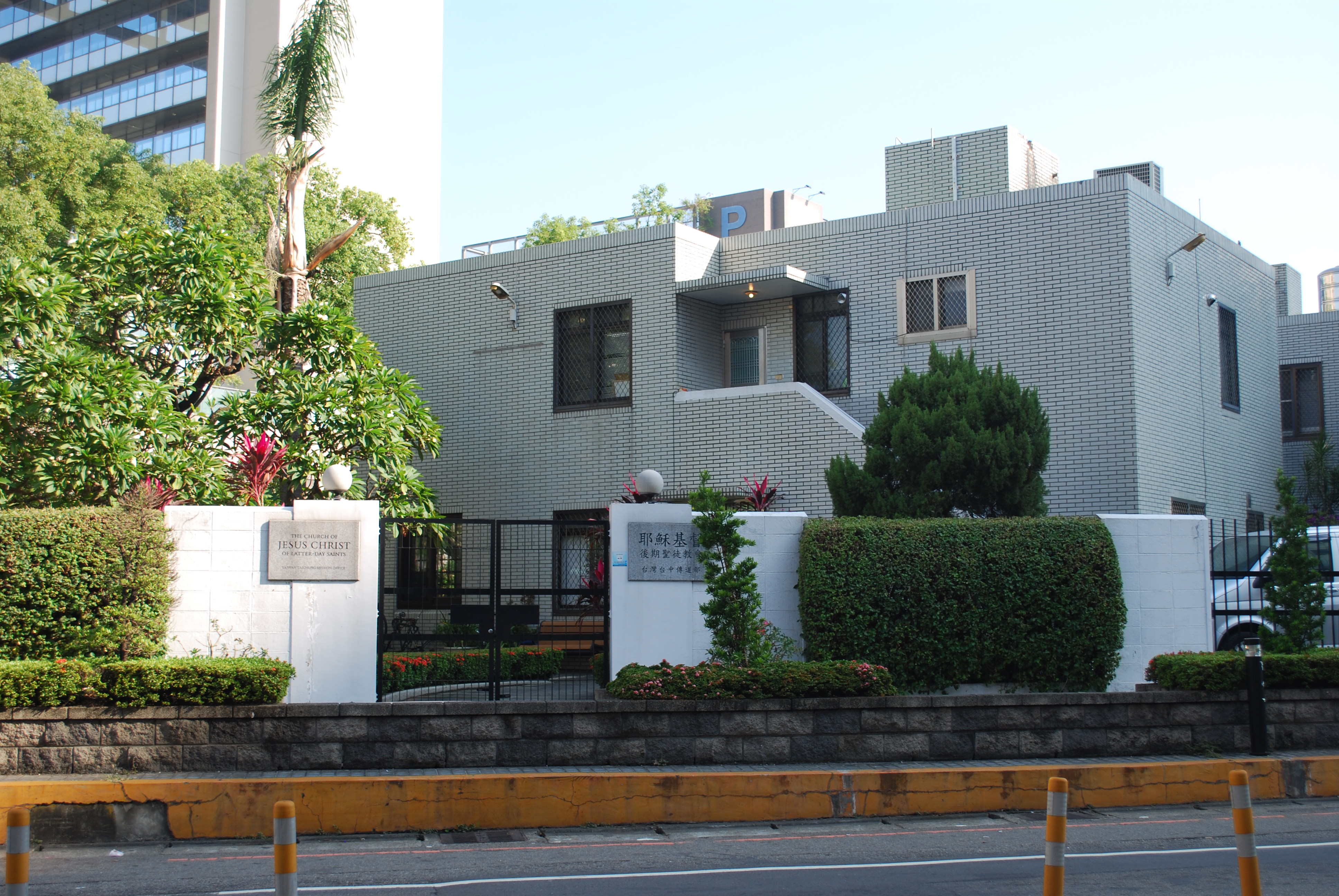 The Taichung mission home and office in 2015. Courtesy of Chou Po Nien (Felipe).
The Taichung mission home and office in 2015. Courtesy of Chou Po Nien (Felipe).
Area Conference in 1980
The Church experienced growth in Taiwan during the 1980s. This development was partly due to the Church’s continued effort to nurture a positive relationship with the government in Taiwan and meetings with high-level government officials. The Church’s adherence to its political-neutrality policy, while respecting and complying with local laws, allowed it to preserve good relationships with the government in Taiwan.[46]
Meeting Taiwan Government Officials
On 22 and 23 October 1980, President Kimball returned to Taiwan to preside over the second area conference in Taiwan. Before the area conference, President Kimball had the opportunity to “have breakfast at [the] hotel with the two top leaders of the Republic of China, Prime Minister Sun [Yu-suan] and President Chiang [Ching-kuo], son of the late Chiang Kai-shek . . . [and] later had lunch as guests of the governor of [the] Taiwan Province.”[47]
Just prior to arriving in Taiwan, President Kimball had surgery and was thus traveling with his wife and doctor, along with other General Authorities. Wang Lu Pao (王綠寶), who was responsible for the prophet’s security in Taiwan, was asked to be familiar with the roads and the location of the nearest medical facilities along the route. Wang recalled assisting President Kimball when he was very cold in his hotel room in the middle of the night. He also recalled escorting the prophet inside the hotel for about twenty minutes during a morning walk. The first experience reminded Brother Wang that President Kimball was an elderly man and needed help, and the latter experience left him with a strong feeling that this elderly man was the Lord’s prophet.[48]
Wang also remembered when the Taiwan president, Chiang Ching-kuo, came to the hotel to have breakfast with President Kimball and David M. Kennedy, special representative of the First Presidency and a personal friend of officials in the Taiwanese government. President Chiang thanked President Kimball for the Church’s help in Taiwan.[49] This was the first time the government in Taiwan publicly praised the Church’s efforts and its presence in Taiwan.[50]
President Chiang knew that President Kimball was traveling to Japan to dedicate the Tokyo Japan Temple and asked when the Church would build a temple in Taiwan. President Kimball responded by saying the Church would build one when Taiwan has enough members and temple workers. President Chiang said, “I hope you can have it soon.”[51]
Three months earlier, the governor of the Taiwan Province, Lin Yang-kang, had visited Utah and signed a treaty of friendship with Utah governor Scott M. Matheson.[52] Thereafter, Lin announced that the Taiwan Province and the state of Utah were officially sister states. This agreement “pledged cooperation in people-to-people programs, cultural exchanges and increased trade.” On that trip, Lin also met with LDS Church President Spencer W. Kimball and the First Presidency. Consequently, when President Kimball came to Taipei, Lin hosted Kimball in Taipei to a twelve-course luncheon.[53] At a formal luncheon, Lin offered a toast to his guests, acknowledging that it was a Chinese custom to greet guests with wine. However, he made an exception. “In keeping with the Mormon custom,” he said, “we would drink 7-Up instead today and use the soda to express our best wishes.”[54] This experience demonstrates an increasing understanding in Taiwan of the Church and its beliefs.
Area Conference
During his trip, President Kimball presided over the area conference held at the Sun Yat-sen Memorial Hall. Wang Hui-Ching (Emily) (王惠卿) said she was excited to attend the meeting with President Kimball in 1980 because she had never before seen a prophet in person. She recalled rushing after school in her school uniform to the meeting. She said that the meeting “was filled with light and everyone was so happy to see the prophet.”[55] Those who attended were able to hear the prophet teach and testify of the Savior before he traveled to Japan to dedicate the first temple in Asia.
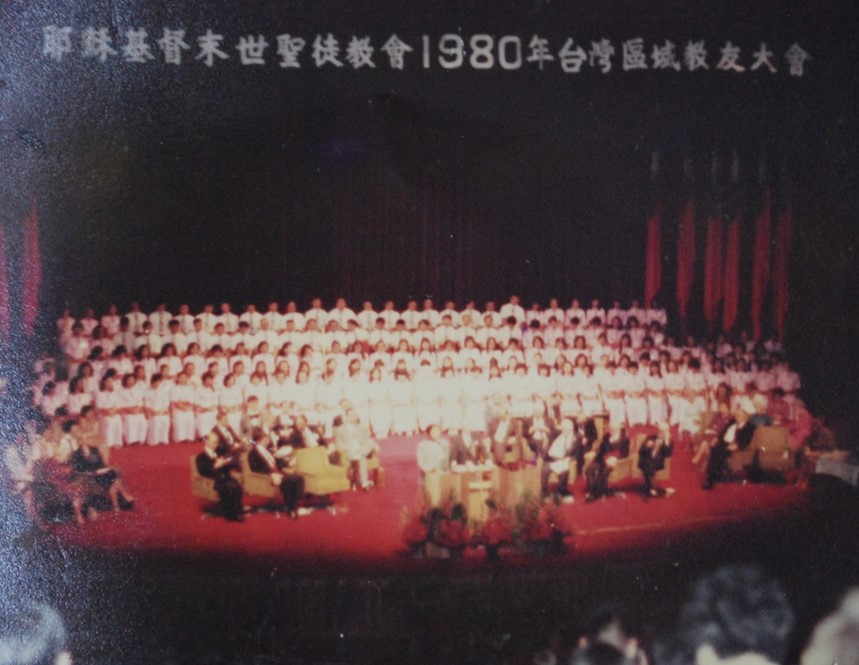 President Spencer W. Kimball returned to Taiwan in 1980 for an area conference. Courtesy of Chang Chen Yu-Ying.
President Spencer W. Kimball returned to Taiwan in 1980 for an area conference. Courtesy of Chang Chen Yu-Ying.
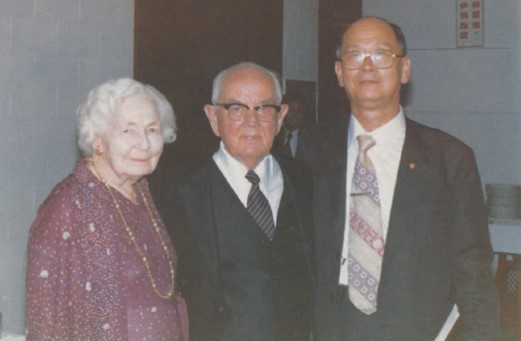 President Spencer W. Kimball visits Taiwan in 1975 and 1980. From left to right: Sister and President Kimball and Chang I-Ching. Courtesy of Chang Ting-Tsung.
President Spencer W. Kimball visits Taiwan in 1975 and 1980. From left to right: Sister and President Kimball and Chang I-Ching. Courtesy of Chang Ting-Tsung.
President Chang I-Ching was among the 2,200 people who attended the meeting and called those days “times of great blessings.”[56] Chang’s son Chang Ting-Tsung (張定宗) remembered how grateful his father was to see so many members attending the area conference. Chang Ting-Tsung also said, “President Kimball promised that when we had 500 local missionaries, China would open its door.”[57] Sister Yang Peng Mei-Jyan (楊彭美堅), who sang in the ward choir, said, “President Kimball encouraged us to prepare 500 local missionaries before China will open its doors.”[58] Sister Wang Li-Fang (王麗芳) sang in the choir and said, “I was honored to see a living prophet. . . . [It] is hard to describe the spiritual feeling experienced from a humble servant of God. I always remembered his promise to us during the meeting that if we have 500 local missionaries from Taiwan, doors will open in mainland China.”[59]
Brother Weng Chen-Hua (翁振華), who had just returned from his mission in Taipei in 1979, was among those who attended the area conference in 1980. He reported that he had the opportunity shake hands with the prophet. He reflected, “When I shook hands with him, I could feel that he is the Lord’s prophet. Before I knew about prophets, but I didn’t know what that meant until that moment.”[60] Sister Mao Chang Mei-Yun (毛張美雲), who attended the 1975 and 1980 area conference, also sang in the choir and shook hands with President Kimball.
New Stakes Organized in Kaohsiung and Taipei
As discussed earlier, the first stake in Taiwan was created in Taipei in 1976. Two new stakes were organized in the following six years after the first stake was created in Taipei. These included the first stake in Kaohsiung, in southern Taiwan, as well as a second stake in Taipei, in northern Taiwan. The missionaries serving in the Kaohsiung Mission were elated to hear that a stake would be created in Kaohsiung. They recorded, “On August 27th a telephone call came from Hong Kong. The message brought what people have [desired] for many years here in the Kaohsiung mission area. The wonderful news is the First Presidency has OKed a stake to be built here. . . . This has excited the members and the leaders alike, not to mention the missionaries.”[61] Brother Weng Chen-Hua (翁振華) recalled that “the members helped to renovate the Kaohsiung chapel before Elder Howard W. Hunter came to organize the first stake in Kaohsiung.” Weng said, “The members would come once a week to donate their time to spruce up the chapel.”[62]
On 6 November 1981, Ho Tung-Hai (何東海) was called by Elder Howard W. Hunter of the Quorum of the Twelve as the stake president for the newly organized Kaohsiung Taiwan Stake, the first stake in southern Taiwan.[63] It was a blessing for the Saints in southern Taiwan to have their own stake organized. Wang Hsu-Hsueh (王緒學), who served as Ho’s counselor in the stake presidency, would succeed him as the next stake president in August 1983.[64] With a new stake organized, several local leaders were called as bishops for the new wards created. Hsu Ming-Chuan (許明泉), who was called to serve as the first bishop for the Pingtung Ward, said that “the members were grateful when Elder Hunter came in 1981” to organize the Kaohsiung Taiwan Stake. Hsu served as a bishop from 1981 to 1997 and recalled that during those early years members, had to rely on themselves to do the Lord’s work. After a short month as a high councilor in 1997, Hsu was called to serve as the first Pingtung Taiwan District president.[65]
Sister Chang Chen Yu-Ying’s (張陳玉英) husband, Chang Fu Chuan (張福全), who had served as a Kaohsiung District president in the 1970s and helped with the translation of several Church books, was called by Elder Hunter to be the first stake patriarch of the newly organized Kaohsiung Taiwan Stake in 1981. Sister Chang said she was grateful to meet Elder Hunter and that her husband was humbled by the call. During his time as a stake patriarch, Chang would provide over 320 patriarchal blessings to the members of the Church in southern Taiwan before he passed away.[66]
A few months after the Kaohsiung Stake was organized, the Taipei Taiwan Stake was divided by Elder David B. Haight of the Quorum of the Twelve on 14 March 1982. Chang I-Ching (張漪清) was the first stake president for the Taipei Taiwan Stake, which was later renamed the Taipei Taiwan West Stake. Meanwhile, with the division of the Taipei Taiwan Stake, Yen Yuan-Hu (嚴元琥) was called as the stake president for the newly created Taipei Taiwan East Stake on 14 March 1982. This stake was the third in Taiwan and the second in Taipei, or the northern region of the island.
As new Church units and meetinghouses were established, open houses helped others in the community become acquainted with the Church and its basic tenants. In 1987, for example, a two-week open house for the stake center of the Taipei Taiwan East Stake would welcome over 1,100 visitors. During this open house, there were displays on the purpose of life as well as the life of Christ and his restored Church. Members served as tour guides during the open house, while choirs performed. At this open house, “more than a hundred of copies of the Book of Mormon were distributed.”[67] It was a great opportunity to welcome members of the community, teach Church beliefs and basic tenants of the faith, and share copies of the Book of Mormon.
Local Chinese Mission President and Missionaries
The First Chinese Mission President
During the 1980s, the Taiwan Taipei Mission in the northern part of the island had Paul H. Hyer serve as a mission president from 1982 to 1985, Chen Yung-Chu (Larry) (陳勇助) from 1985 to 1988, and Patrick H. Price from 1988 to 1991. On 1 July 1985, Chen Yung-Chu (Larry) would become the first Chinese person from Taiwan to serve as a mission president. Chen was forty-three years old at the time of his call and was living in Hawaii, serving as a high councilor. The announcement in Church News noted that he was born in Fengyuan, served in the Southern Far East Mission from 1965 to 1967, and married his wife, Chen Lin Mei-Yu (Rebecca) (陳林美玉), in June 1975 in the Laie Hawaii Temple.[68]
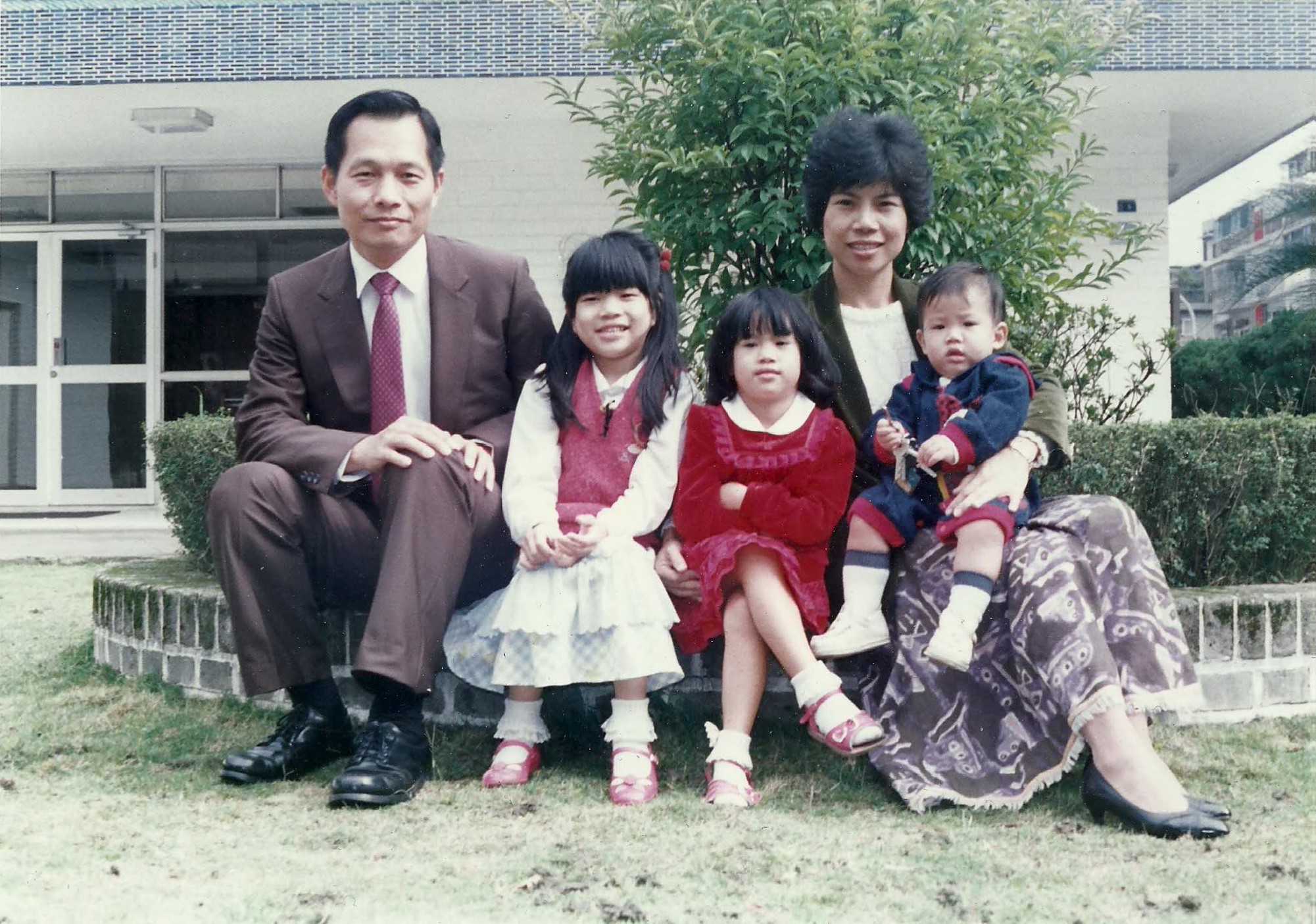 First Chinese mission president, Chen Yun-Chu (Larry), with wife Chen Lin Mei-Yu (Rebecca) and their children in 1985. Courtesy of Chen Yun-Chu (Larry).
First Chinese mission president, Chen Yun-Chu (Larry), with wife Chen Lin Mei-Yu (Rebecca) and their children in 1985. Courtesy of Chen Yun-Chu (Larry).
As noted in chapter 4, Chen Yu-Chu (Larry) was converted in the 1960s after working with his brother on the first chapel in Taiwan. After his conversion, Chen desired to serve a mission, but at that time, prospective missionaries did not apply for a mission; rather, the branch president would consider and recommend those he thought would be worthy and capable to serve. Furthermore, it was not typical to call males in Taiwan to serve missions, since many had military obligations. Chen, however, already completed his military service, had a desire to serve, and prayed that he might be called. A few months later, his branch president interviewed him for missionary service, and in December 1965 he received a letter from President David O. McKay calling him to be a full-time missionary in the Southern Far East Mission. Although he had very little money, others helped him purchase a suit, white shirts, and a bicycle for his mission.[69]
After his mission, Chen studied at BYU–Hawaii but returned to Taiwan to marry Lin Mei-Yu in 1975. Chen returned to Hawaii to complete his undergraduate studies in social work at BYU–Hawaii, and then he pursued a master’s degree at the University of Utah. He was living with his wife and two young children and working for the LDS Social Services in Hawaii when President Gordon B. Hinckley called him to serve as the first Chinese mission president. Chen noted that his social work background helped him as a new mission president.[70]
Chen’s wife, Lin Mei-Yu, was a nurse and the first Chinese health missionary when she was called as a full-time missionary in 1973. As mentioned in chapter 5, Sister Lin was a new convert after being baptized in Fengyuan in 1972 and remembers a call from Malan Jackson, then president of the Taiwan Mission, asking her to serve a mission. She was not quite sure what that meant, but she was obedient and answered the call to serve. When her mother asked her how long it would be, she was not sure and thought it might be for a month. Sister Lin would serve for eighteen months, helping to teach members and missionaries about health. While serving as a health missionary, Sister Lin met Brother Chen, who had been sent by his professors at BYU–Hawaii to conduct research in Taiwan. Lin finished her mission in February 1975; Chen returned to Taiwan in April, and they were married on 10 May 1975 at the Jing Hua Street chapel in Taipei by Thomas P. Nielson. Then they returned to Hawaii and were sealed in the Laie Hawaii Temple on 18 June 1975.[71]
Sister Chen Lin Mei-Yu said that while her husband served as the mission president, she was the mission mom, friend, nurse, and older sister to their missionaries. She recalls teaching an elder how to sew his torn pants after this elder used staples to repair them. She helped with the physical and emotional health of their missionaries by helping them adjust to their new culture and environment and being a big sister to the sister missionaries. She performed these many tasks admirably while also caring for their young family. The Chens had two young children at the time of their call. Sister Chen gave birth to their third child shortly after arriving in Taiwan, and their fourth child arrived two years later while they continued to preside over the Taipei Mission. The Chens were humbled by the call to serve. They had a deep testimony of the Savior and were examples of simple faith and obedience to the Lord’s call to serve.[72]
Lee Shih-Jung (Robert) (李世榮), who served as one of President Chen’s assistants, noted that Chen trusted his assistants. Lee related that “on one occasion, there was a problem with a missionary with long hair and President Chen sent us [the assistants to the president] to help this missionary change and then report back. He trusted us.” Lee also added that as the first Chinese mission president, Chen was under much pressure to ensure the success of the mission and was quite strict. He recalled that Chen once said, “I am the first native mission president, and if I don’t do well, the Brethren may not allow another local mission president in the future.”[73]
Sister Tsai Shu-Min (Bridget) (蔡淑敏) was a local missionary who served under two mission presidents, including President Chen. She said Chen taught her that the “mission school” was more important than a four-year college and encouraged the missionaries to seriously study the Book of Mormon because it changes hearts. Tsai recalled that Chen said to the missionaries, “Why are you called to serve in Taipei? It is to prepare future leaders of the Church in Taiwan.” According to Tsai, “President Chen often called to see if those called could report to the mission earlier and during his time, instead of the typical 5–6 local missionaries, there were . . . over 30 local missionaries serving.”[74]
Brother Yang Shih-Ning (楊世寧), another missionary who served under Chen, also noted about thirty to forty local missionaries serving at that time, which was unusually high. Yang felt that there was a significant change in the mission because it had a Chinese mission president. Yang noted that since his mission president had lived in the United States, local missionaries thought he was too American, while American missionaries thought he was too Chinese. However, Yang reported that Chen worked hard, was very patient, and brought a unique perspective in his thinking and working with missionaries—a mindset that was half Chinese and half American. President Chen often checked with local leaders for prospective missionaries that might be able to serve, asked missionaries already called if they were able to report early, and invited those serving if they were able to extend.[75]
Sacrifices of Local Missionaries
Sister Tsai Shu-Min’s (Bridget) (蔡淑敏) story provides an example of the courage and strength of the local missionaries serving during this time. Tsai first met the missionaries in the park and later biked with them to church. Although her father initially didn’t allow her to join any church, Tsai was baptized in 1985 in Chiayi after many prayers. She had a desire to serve a mission and traveled from Chiayi to Pingtung to receive her patriarchal blessing from patriarch Brother Chang when she was twenty years old. Prior to giving her the blessing, the patriarch said to her, “Women do not need to serve missions, so don’t worry about it.” Nevertheless, Tsai reported that when she was given her patriarchal blessing, it mentioned she would serve a mission. Her desire to serve a mission increased, and she hoped to serve when she turned twenty-one years old.[76]
Tsai recalled that when she told her father she wanted to go on a mission, “[He] got very upset and my mother also tried to stop me from going.”[77] Despite the family opposition, she was called to serve as a full-time missionary in the Taipei Mission from 1987 to 1989. While serving as a missionary, she received a call from her father telling her not to come back home. She also received an angry letter from her sister. Still, she kept writing letters home to share her love with her family. Tsai felt she had been significantly blessed for serving a mission even though her family had not yet joined the Church. She would later marry in the temple, and each of her three children would serve as full-time missionaries for the Church. In fact, Tsai’s daughter and the daughter of a woman Tsai converted in Yong-he briefly served together as missionary companions in New Zealand.[78]
Brother Yang Shih-Ning, a missionary who served under President Chen, is another example that illustrates the faith and sacrifice of missionaries who served during this time. After being discharged from the military earlier than anticipated, Yang decided to go on a mission and went to talk with his bishop. At that time, the bishop discouraged him from going on a mission and instead encouraged him to go to college first. However, Yang still wanted to go, so he went to Tainan to interview with his stake president. Yang said, “My stake president told me he would send it out, but that same night the Taipei Mission president [Larry Chen] called my stake president to see if there were anyone who could be recommended.”[79]
After Yang’s stake president told Chen that he had just interviewed Yang, Chen called Yang and asked, “Can you take the train and come tonight to start your mission?” Yang reported that his mom had recently been baptized and was fine with him going, but when Yang spoke to his father, his father did not approve. Yang said, “My father was upset and yelled at me. He threw all my stuff out the door from the fourth floor where we lived, so I packed my things in the staircase and left to Taipei to start my mission without having a mission call yet.” About three or four months after starting his mission, Yang received a letter with his mission call.[80]
Moreover, Yang provided insight into the missionary efforts used during this period. His mission president asked the missionaries to focus on finding and baptizing families, so Yang identified six families in which an active wife had a nonmember husband. One sister was employed to clean the chapel, and her husband helped her but disliked the missionaries because they would leave the chapel dirty. For two months, Yang and his companion got up at 5 a.m. to help this sister clean the chapel. They also helped these families with babysitting, fixed and painted their homes, helped decorate Christmas trees, and left messages or cards. One man remarked, “I thought I loved my family the most, but I was wrong. You elders love my family more.” Yang said, “It took a long time before we began teaching them, but once lessons began, baptisms came quickly.”[81] Yang was asked by Chen to extend his mission (a common practice for Chen during his time as mission president) and served for two years and eight months in total.[82] After his mission, Yang would marry in the temple, help translate for the Church, and serve as a stake president. Yang’s experience illustrates the sacrifice made by new converts who served missions during this time.
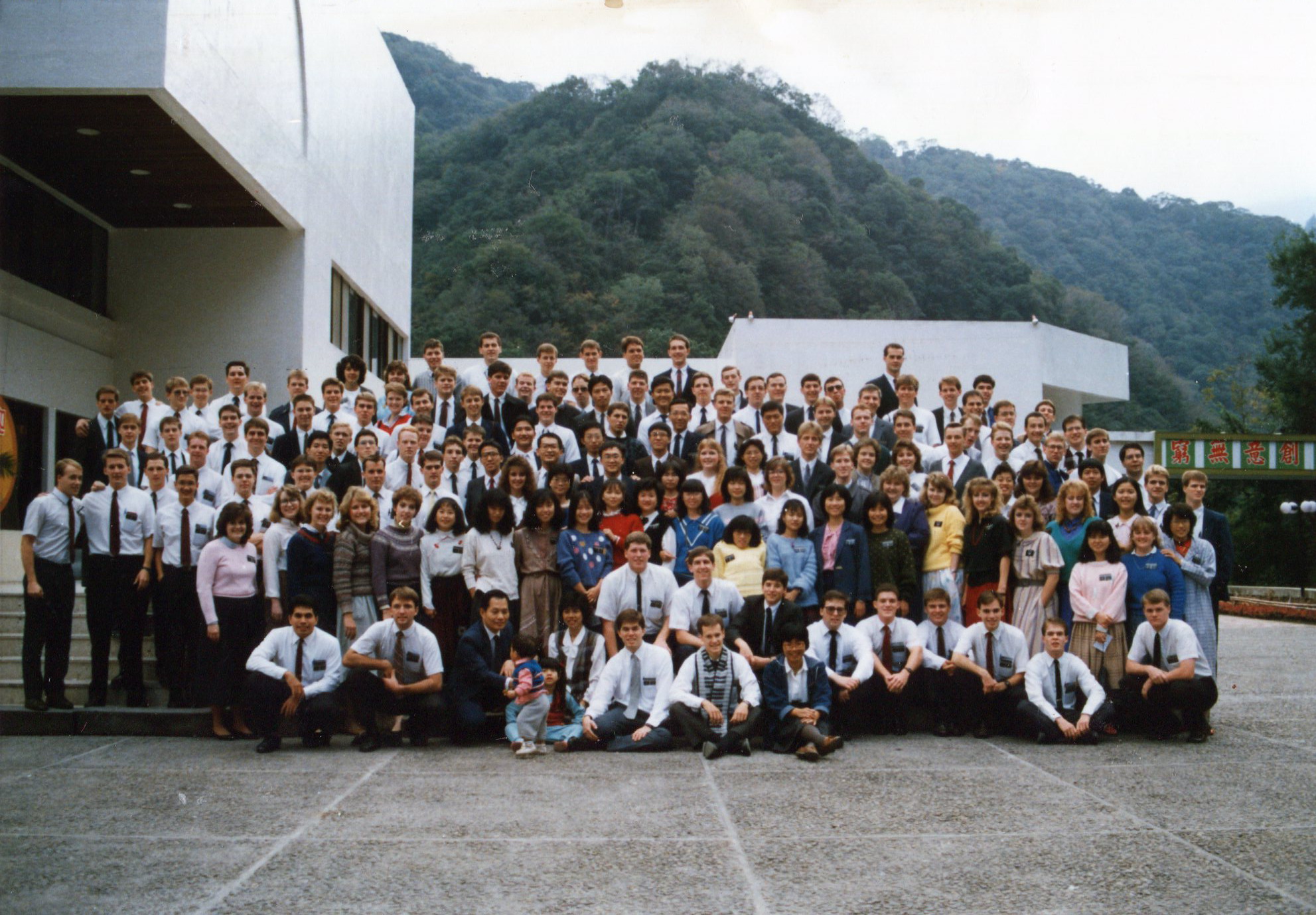 Mission conference in Hualien in 1986. Courtesy of Chen Yu-Chu (Larry).
Mission conference in Hualien in 1986. Courtesy of Chen Yu-Chu (Larry).
Sister Hsu Hsiu-Ying (徐秀瑛) was another who served a full-time mission during this period. Throughout 1984, she had written four letters to her father to express her desire to serve a mission. Following a typhoon and damage to the house, her father asked her, “The house is flooded and you are still leaving on a mission?” She was called to serve in the Taichung Taiwan Mission and went on her mission in October 1985. Although her parents were not happy with her decision, Hsu said that during the Chinese New Year, “my father came to see me and brought me some money, even though we were poor at the time.” Her sisters also helped her financially during her mission, and the family debt was gone after her mission.[83] Although her father did not join the Church, the Lord softened the heart of her family.
Although Hsu began in the Taichung Taiwan Mission, after nine months she was sent with a few others to serve in the Taipei Taiwan Mission to help with genealogy, where she stayed for the next ten months until the end of her mission. Hsu said that her seven years of seminary and institute helped her a lot on her mission, where her “knowledge turned to wisdom.” Moreover, she said, “A lot of institute students including my friends were going out to serve missions.” Although she had some health problems, including back pain, she said she had made a commitment and therefore stayed until the end of her mission. Her mission president, Larry Chen, asked her to stay longer, so she extended her mission. She was blessed to be able to serve a mission.[84]
During this period, Chen had many local missionaries who sacrificed much to be able to serve. Their faith and devotion despite family opposition, which was common to local converts who exercised faith in going forth to serve the Lord as full-time missionaries, are a credit to the members of the Church in Taiwan. These missionaries, and others like them, were paving the way for a temple in Taiwan.
Conclusion
The turbulent political environment during this time (1975–85) affected the people in Taiwan, including religious groups. Nevertheless, the LDS Church maintained political neutrality and continued to grow during this time. Perhaps the most important events for the Church in Taiwan during this period were the visits by the President of the Church to preside over area conferences in Taiwan. After President Kimball’s first visit in 1975, the first stake and additional missions were created in Taiwan. New converts from this period would include future stake presidents, Area Seventies, and the first Chinese temple president. During President Kimball’s second visit in 1980, he met with government officials in Taiwan. This was followed by the organization of additional stakes and the call of the first Chinese mission president in Taiwan, resulting in increased numbers of local missionaries.
Notes
[1] Joseph S. Murdock, “Come, Listen to a Prophet’s Voice,” Hymns (Salt Lake City: The Church of Jesus Christ of Latter-day Saints, 1985), no. 21.
[2] Stamps and Shamo, The Taiwan Saints, 90.
[3] A version of this section appears in print in Chou Po Nien (Felipe), “History of the Church in Taiwan in the 1970s,” in The Worldwide Church: The Global Reach of Mormonism, Brigham Young University 2014 Church History Symposium, ed. Mike Goodman and Mauro Properzi (Provo, UT: Religious Studies Center, 2016), 121–42; Ng Shee-Nan and Chin Ching-Man, The Church of Jesus Christ of Latter-day Saints: History in Hong Kong, 1949–1997, trans. Anita Chin (Hong Kong: Printforce, 1997), 102–5.
[4] Britsch, From the East, 271–77.
[5] Harry Harding, A Fragile Relationship: The United States and China since 1972 (Washington, DC: Brookings Institution, 1992); William Heaton, “China and the Restored Church,” Ensign, August 1972, 14–18.
[6] Janice Clark, “Taiwan: Steep Peaks and Towering Faith,” Ensign, August 1975, 55–58.
[7] Thomas P. Nielson, “In Remembrance of President Chiang,” The Voice of the Saints, May 1975, 46.
[8] Kevin Moss, “Conference in Taiwan,” Ensign, 5 October 1975, 91–93.
[9] Accompanying President Kimball were President Marion G. Romney, second counselor in the First Presidency; President Ezra Taft Benson, President of the Quorum of the Twelve Apostles; Elders Gordon B. Hinckley and Marvin J. Ashton of the Quorum of the Twelve; Elders Sterling W. Sill, Theodore M. Burton, James A. Cullimore, O. Leslie Stone, J. Thomas Fyans, and Adney Y. Komatsu, assistants to the Council of the Twelve; Elder Paul H. Dunn of the First Council of the Seventy; Bishop H. Burke Peterson of the Presiding Bishopric; Sister Barbara B. Smith, Relief Society general president; and David M. Kennedy, special representative of the First Presidency.
[10] Moss, “Conference in Taiwan,” 91–93.
[11] Spencer W. Kimball, “We Propose That We Establish a Temple . . . ,” Liahona, October 1980, 2.
[12] Chang Huang Yung Wei, interview by Chou Po Nien (Felipe), 28 October 2015, Salt Lake City.
[13] Christopher K. Bigelow, “Taiwan: Four Decades of Faith,” Ensign, September 1998, 38–46; Chen Hsin Hsiung, interview by Chou Po Nien (Felipe), 15 November 2015, Kaohsiung, Taiwan.
[14] Britsch, From the East, 291–94.
[15] Moss, “Conference in Taiwan,” 91–93.
[16] Feng Xi, “A History of Mormon-Chinese Relations,” 179.
[17] Clark, “Taiwan: Steep Peaks and Towering Faith,” 55–58.
[18] Britsch, From the East, 277.
[19] “Two New Stakes for the Far East,” Ensign, June 1976, 87.
[20] John Hilton III and Chou Po Nien (Felipe), “The History of LDS Seminaries and Institutes in Taiwan,” Mormon Historical Studies 14, no. 2 (Fall 2013): 83–106.
[21] Gerry Avant, “Touched By Poverty: Former Military Officer Keeps Vow,” Church News, 24 March 1985, 6.
[22] Avant, “Touched By Poverty: Former Military Officer Keeps Vow,” 6.
[23] Britsch, From the East, 282.
[24] Those who served as stake presidents for this stake after Chang I-Ching included Liu Ch’un Hua (劉春華) from 1982 to 1987, Liang Shi An (Kent) (梁世安) from 1987 to 1992, Yang Tsung-Ting (Jared) (楊宗廷) from 1992 to 2001, Chao Chiung Min (James) (趙炯民) from 2001 to 2005, Cheng Chuo Fu (卓復政) from 2005 to 2014, and Wang Yao Ting (王耀廷) from 30 November 2014 to present.
[25] In 1973, the members in Taiwan were blessed to receive a visit by the presiding Patriarch of the Church, Eldred G. Smith. Elder Smith would often travel to areas of the world where there were no patriarchs in order to give patriarchal blessings to worthy members of the Church. “Eldred G. Smith,” Wikipedia, last modified 16 May 2016, http://
[26] Wang Li-Ching (Sandy Lee), phone interview by Chou Po Nien (Felipe), 18 November 2013.
[27] “Taiwan Saints Eager for Temple Blessings,” 107–9.
[28] Clark, “Taiwan: Steep Peaks and Towering Faith,” 55–58.
[29] Wang Li-Ching (Sandy Lee), phone interview by Chou.
[30] “Eleven New Missions Formed This Year,” Ensign, June 1976, 87–88.
[31] Harding, A Fragile Relationship: The United States and China since 1972, 67–69.
[32] “Taiwan Saints Eager for Temple Blessings,” 107–9.
[33] Britsch, From the East, 262–65.
[34] “Telegram from the U.S. Pacific Command to the Department of State and the White House,” in Foreign Relations of the United States, 1977–80 (Washington, DC: US Government Printing Office, 1991), 13:680–86.
[35] Rubinstein, Protestant Community on Modern Taiwan, 3–5; Feng Xi, “A History of Mormon-Chinese Relations,” 176.
[36] Feng Xi, “A History of Mormon-Chinese Relations,” 176.
[37] Britsch, From the East, 263–66.
[38] Feng Xi, “A History of Mormon-Chinese Relations,” 185–87.
[39] Britsch, From the East, 263–66.
[40] “History of the People’s Republic of China,” http://
[41] Britsch, From the East, 277–78.
[42] “Nine New Missions Announced,” Ensign, June 1979, 76.
[43] Britsch, From the East, 283–84.
[44] Feng Xi, “A History of Mormon-Chinese Relations,” 190–205.
[45] Feng Xi, “A History of Mormon-Chinese Relations,” 190–205; After Carlson, Gary S. Williams (衛廉士) served as the mission president for the consolidated mission from 1986 to 1989, followed by Kent D. Watson (孫小山) from 1989 to 1992.
[46] Feng Xi, “A History of Mormon-Chinese Relations,” 190–205.
[47] Spencer W. Kimball, “A Report of My Stewardship,” Ensign, May 1981, 5–7.
[48] Wang Lu Pao, interview by Chou Po Nien (Felipe), 18 November 2015, Taipei, Taiwan.
[49] Wang Lu Pao, interview by Chou.
[50] Feng Xi, “A History of Mormon-Chinese Relations,” 190–205.
[51] Wang Lu Pao, interview by Chou.
[52] Feng Xi, “A History of Mormon-Chinese Relations,” 190–205.
[53] Wang Lu Pao, interview by Chou.
[54] Feng Xi, “A History of Mormon-Chinese Relations,” 190–205.
[55] Wu Wang Hui-Ching (Emily), interview by Chou Po Nien (Felipe), 21 November 2015, Taipei, Taiwan.
[56] Jerry P. Cahill, “News of the Church: Times of Great Blessings: Witnessing the Miracles,” Ensign, January 1981, 70–75.
[57] Chang Ting-Tsung, interview by Chou Po Nien (Felipe), 17 November 2015, Kaohsiung, Taiwan.
[58] Yang Peng Mei-Jyan, interview by Chou Po Nien (Felipe), 16 November 2015, Kaohsiung, Taiwan.
[59] Tsai Wang Li-Fang to Chou Po Nien (Felipe), email, 11 March 2016.
[60] Weng Chen-Hua, interview by Chou Po Nien (Felipe), 17 November 2015, Kaohsiung, Taiwan.
[61] Taiwan Kaohsiung Mission Historical Records, August 1981, Church History Library (LR 15526 3).
[62] Weng Chen-Hua, interview by Chou.
[63] Hsu Ming-Chuan, interview by Chou Po Nien (Felipe), 16 November 2015, Kaohsiung, Taiwan.
[64] Tsai Wang Li-Fang to Chou Po Nien (Felipe), email, 17 February 2016.
[65] Ming-Chuan, interview by Chou.
[66] Chang Chen Yu-Ying, interview by Chou Po Nien (Felipe), 17 November 2015, Pingtung, Taiwan.
[67] “LDS Scene: More than 1,100 visitors toured the East Taipei stake center in Taipei, Taiwan, during a two-week open house,” Ensign, May 1987, 112.
[68] “Hawaiian, Salt Laker to Head Missions: Will Take Positions Around First of July,” Church News, 17 February 1985, 6.
[69] Chen Yung-Chu (Larry), interview by Chou Po Nien (Felipe), 7 November 2015, Murray, UT.
[70] Chen Yung-Chu (Larry), interview by Chou.
[71] Chen Lin Mei-Yu (Rebecca), interview by Chou Po Nien (Felipe), 7 November 2015, Murray, UT.
[72] Chen Lin Mei-Yu (Rebecca), interview by Chou.
[73] Lee Shih-Jung (Robert), interview by Chou Po Nien (Felipe), 16 November 2015, Kaohsiung, Taiwan.
[74] Lee Tsai Shu-Min (Bridget), interview by Chou Po Nien (Felipe), 16 November 2015, Kaohsiung, Taiwan.
[75] Yang Shih-Ning, interview by Chou Po Nien (Felipe), 16 November 2015, Kaohsiung, Taiwan; Lee Tsai Shu-Min (Bridget), interview.
[76] Lee Tsai Shu-Min (Bridget), interview by Chou.
[77] Lee Tsai Shu-Min (Bridget), interview by Chou.
[78] Lee Tsai Shu-Min (Bridget), interview by Chou.
[79] Yang Shih-Ning, interview by Chou; Lee Tsai Shu-Min (Bridget), interview by Chou.
[80] Yang Shih-Ning, interview by Chou; Lee Tsai Shu-Min (Bridget), interview by Chou.
[81] Yang Shih-Ning, interview by Chou.
[82] Yang Shih-Ning, interview by Chou.
[83] Hsu Hsiu-Ying, interview by Chou Po Nien (Felipe), 20 November 2015, Taipei, Taiwan.
[84] Hsu Hsu-Ying, interview by Chou.
